Conquistadors of the Useless (57 page)
Read Conquistadors of the Useless Online
Authors: Geoffrey Sutton Lionel Terray David Roberts
Jannu
(Kumbharkama). After reconnaissance in 1957 (by Magnone, Bouvier, Leroux and Gyaltsen Norbu) the southern glacier approach was tackled by Jean Franco (leader), Lionel Terray, Robert Paragot, Guido Magnone, Maurice Lenoir, René Desmaison, Jean Bouvier, Pierre Leroux, James Lartizien+, Jean-Michel Freulon, Philippe Dreux and Wangdi (sirdar) plus other sherpas. They climbed the complex south-west ridge to 310 metres below the summit.
At Grips with Jannu
by Jean Franco and Lionel Terray (Gollancz, London 1967)
Piz Badile.
North-east face with Suzanne Valentini (9 Aug).
1960
Obergabelhorn
. North-east face with Kees Egeler and Tom De Booy
1961
Terray fell when ledge collapsed on the cliffs of Le Saussois. Broke ribs.
Les Conquerants de t'lnutile
published (Librarie Gallimard, Paris).
1962
Jannu
(Kumbhakarna). § South glacier south-west ridge. The summit was reached by René Desmaison, Paul Keller, Robert Paragot and Gyaltsen (27th April). The climb was repeated (28th April) by André Bertrand, Jean Bouvier, Paul Leroux, Yves Pollet-Villard, Jean Ravier, Lionel Terray (leader) and Wangdi (sirdar). Also involved were Maurice Lenoir, René Vernadet (cameraman), Guy de Haynin+, Philippe Dreux and Jean-Marcel Rémy. Bottled oxygen proved crucial to success on this difficult route.
At Grips with Jannu
by Jean Franco and Lionel Terray (Gollancz, London, 1967);
Total Alpinism
by René Desmaison (Granada, London, 1982). Note â Wangdi is incorrectly spelt Wongdi in official accounts.
Chacraraju Este.
§ July: first ascent by Lionel Terray (leader), Guido Magnone, René Dubost, Jacques Soubis, Paul Gendre. Also involved: Claude Maillard (organiser).
Nilgiri.
§ September/October â the first ascent of the 23,950-foot western satellite of Annapurna by a route up the north face by Peter, Paul and Holger Van Lookeren Campagne, Lionel Terray and Wangdi (19th Oct). Also involved: Tom De Booy and Kees Egeler.
1964
Mount Huntington
§ Lionel Terray (leader), Paul Gendre, Jacques Soubis, Jacques Batkin, Marc Martinetti, Maurice Gicquel, Sylvain Sarthou, Jean-Louis Bemezat tackled the sustained and stubborn south ridge, aided by an ice cave at its base and much fixed rope. Terray had a big fall high on the route (when unbelayed) and was only arrested on thin line he was trailing for fixed rope. On the 26th of May, after eighteen days of struggle in bitterly cold conditions, the summit (12,240 feet/3,731 metres) was reached by Batkin and Sarthou and, in more benign weather, by the six other members of the party (27th May).
1965
Gerbier: Arc de Cercle Crack.
The roped bodies of Lionel Terray and Marc Martinetti were found below this difficult 400-metre rock climb in the Vercors, suggesting a fall while they were moving together (roped but unbelayed) on the easy upper section.
1. FitzRoy is the preferred form of the name (as opposed to Fitzroy, as used in this book, or Fitz-Roy and other hybrids). The mountain was named after Captain FitzRoy, the commander of Darwin's Beagle. He was a member of the Duke of Grafton's family, FitzRoy being the family name.
[back]

Top: Terray
(top left)
as a teenage pupil in his first secondary school â a seminary near Grenoble.
Centre left: Baby Lionel in a romper suit with his father, c.1922 â âan exceptionally vigorous child.'
Centre: Terray as âa Little Lord Fauntleroy', formally dressed for a mountain walk.
Centre right: At the age of fifteen on the Trois Pucelles, his favourite local crag.
Bottom: Terray participating in a regional ski championship during the early war years.
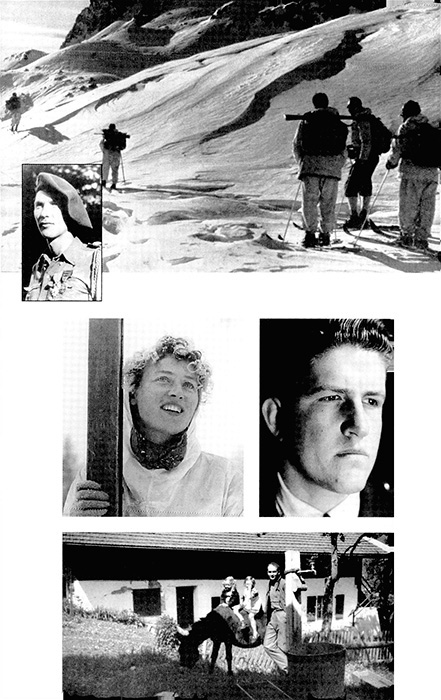
Top: On patrol near the Italian border in 1945 with the French mountain unit led by the inspiring Captain Stéphane
(inset)
.
Centre left: Marianne Perrolaz, who Terray met during a ski event and soon married.
Centre right: Gaston Rébuffat, Terray's early climbing partner â âtall, thin and stiff as an “I”, his somewhat formal manners and learned turn of phrase contrasted comically with a noticeable Marseilles accent. His whole conception of mountaineering, normal enough today, was far in advance of its time and entirely novel as far as I was concerned.'
Bottom: Terray with local children at his farm in Les Houches.

Top: The north faces of the Aiguille de Blatière
(left)
and Aiguille du Plan
(right)
. Dent du Caïman is the most prominent of the rock peaks between them with Col du Caïman at the foot of its pronounced north-east ridge. Reaching this col was the objective of Lionel Terray and Gaston Rébuffat on 1942. They approached up the glacier-filled basin below and traversed the diagonal upper snow ramps to the foot of the slender ice runnel.
Photo: André Contamine
.
Bottom: Dent du Caïman seen from the Fontaine ledges on Aiguille de Blatière. The slender ice runnel leading to the col is directly below the north-east ridge with the prominent Lagarde/Segogne couloir to its right.
Photo: Pierre Chevalier
.

Fissure Allain (grade 6), the crux pitch of the north face of the Petit Dru. While Terray and Oudot struggled with this the following party (Félix Martinetti and Gilbert Ravenal) moved right and found the easier Martinetti Crack â now the normal route of ascent.
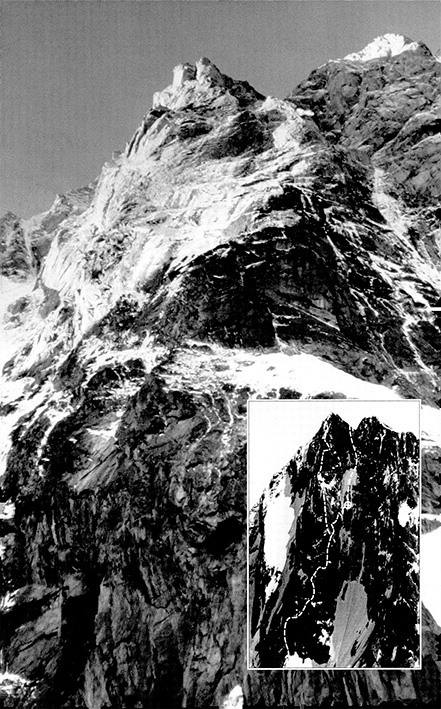
The Walker Spur of the Grandes Jorasses. âI was climbing as never before ⦠our progress was more like a well-drilled ballet than a difficult piece of mountaineering.'
Photo: Alex MacIntyre (Inset)
Terray and Lachenal's finish up the central couloir
(right)
.
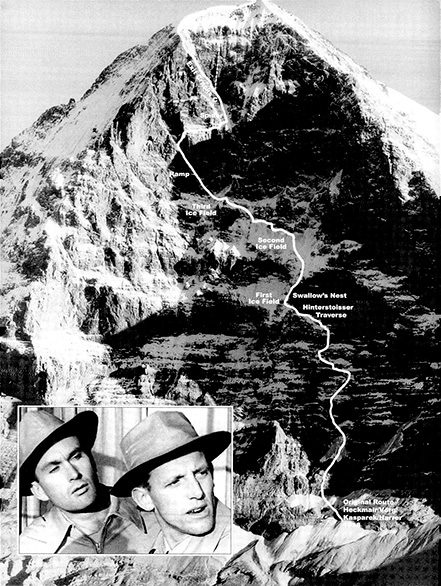
The North Face of the Eiger showing the 1938 route and that of the 1957 rescue efforts. (C = Corti, L = Longhi.) Terray and Lachenal
(Inset)
made their ascent over three days in 1947.
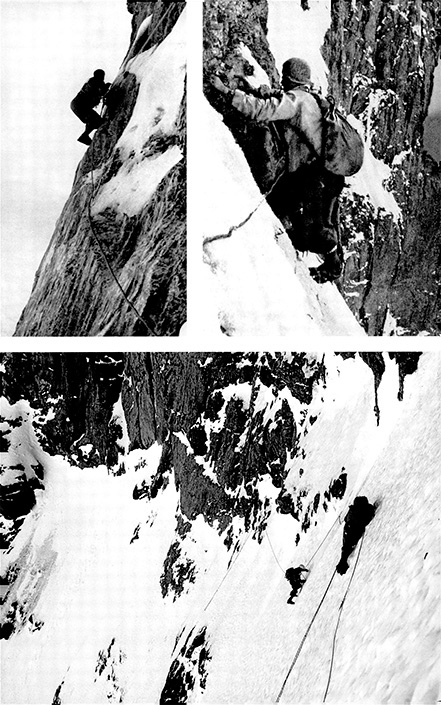
Top left: The Hinterstoisser Traverse.
Photo: Tony Hiebeler.
Top right: The traverse of the Third Icefield to the Ramp.
Photo: Harrer Archive.
Bottom: The Traverse of the Gods.
Photo: Terray Archive.
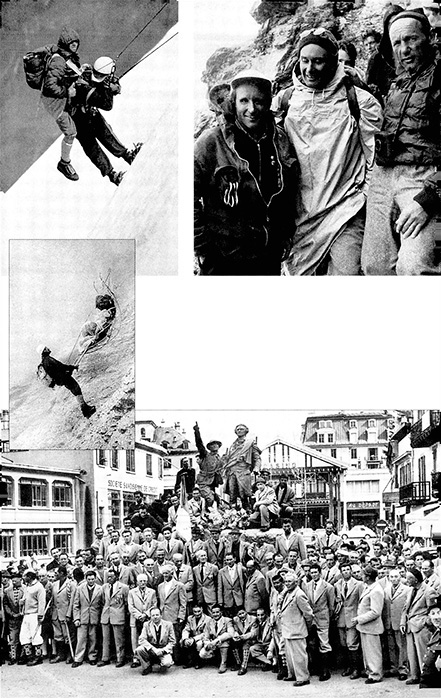
The 1957 Eiger rescue effort. Top left: Alfred Hellepart rescues Claudio Corti from the face.
Top right: Ludwig Gramminger, Lionel Terray and Ricardo Cassin.
Centre: Erich Friedli guides the specially-designed stretcher down the west ridge.
Bottom: Chamonix guides assemble in the main square below Balmat and de Saussure. Terray is on the left (light breeches) and the famous guide Armand Charlet stands in a dark tie (left) behind the central squatting group.